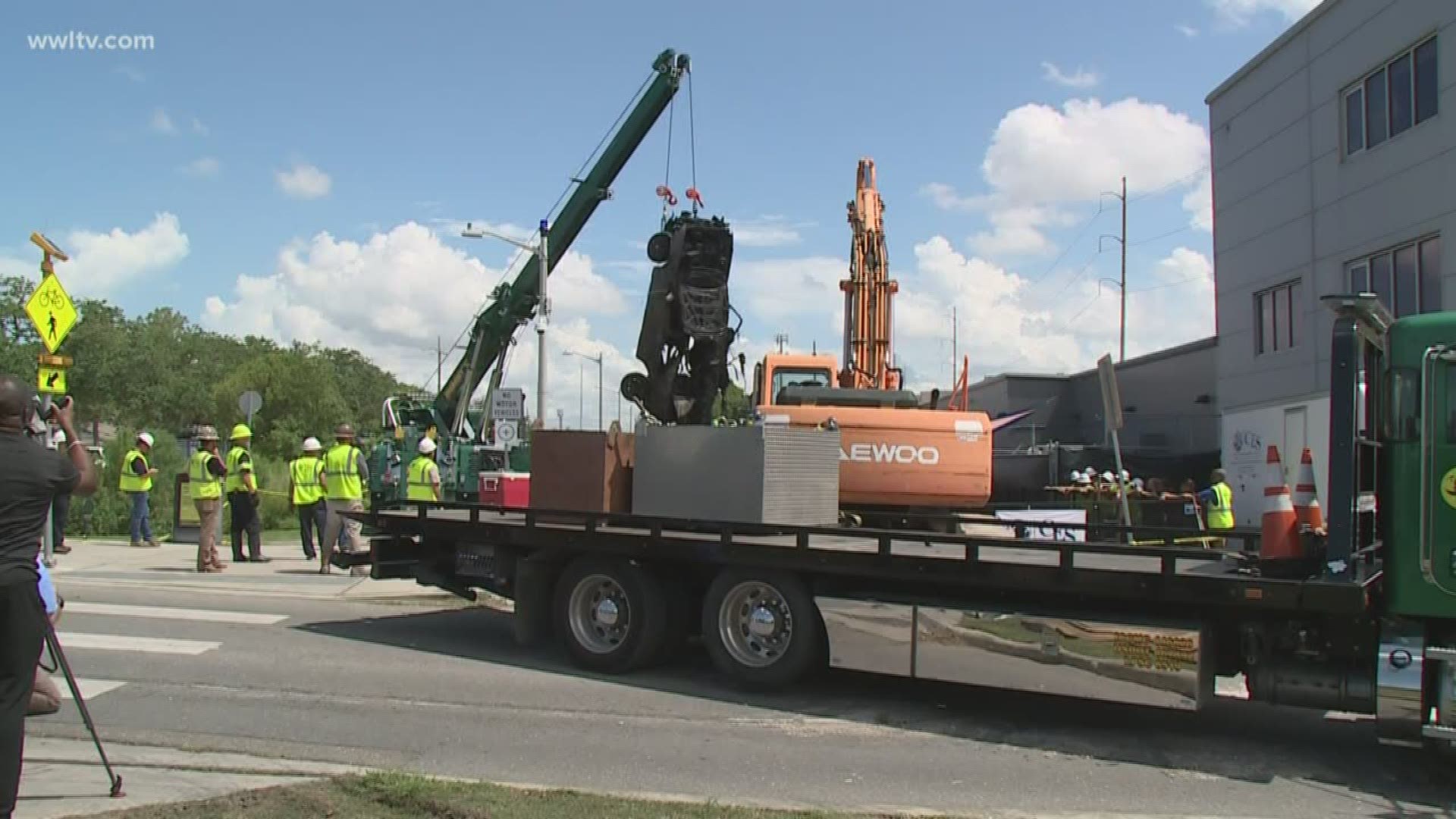NEW ORLEANS — When the Lafitte Canal overtopped July 10, the Sewerage & Water Board looked inside the 2.5-mile stretch that runs under the Lafitte Greenway.
They removed a 2-ton car, along with hundreds of tons of other debris, including another car’s chassis, couches, grills, bicycles and more.
But now S&WB Director Ghassan Korban says that’s barely 2% of the blockage contractors have found, in that one stretch of one canal.
“We’ve cleaned about 500 tons of debris out of that canal. And you think that’s an accomplishment, which it is, in a way,” he said. “But there remains about 20,000 tons left in there.”
Mayor LaToya Cantrell said this needs to be a wakeup call to residents, that their littering is adding to the city’s drainage woes.
“The trash and debris we’re finding in there has been put there by our own people,” Cantrell said, raising her voice. “And that has to stop!”
Cantrell called a news conference Thursday to show what she and other officials called an unprecedented level of coordination between City Hall, the Sewerage & Water Board and the U.S. Army Corps of Engineers.
The city’s Department of Public Works controls 72,000 catch basins and 1,500 miles of drainage pipes that should initially drain the city’s streets; the Sewerage & Water Board runs the system of larger culverts and canals that take water to pump stations, which lift the water up and send it out to Lake Pontchartrain; and the U.S. Army Corps of Engineers, which contributed $1.5 billion to interior drainage projects, such as the SELA box culverts built recently under major Uptown avenues.
RELATED: S&WB chief proposes drainage fee to raise billions for 'complete overhaul' of city's system
After surprising flooding covered wide swaths of the city in May, July and August and damaged buildings and vehicles in places that hadn’t tended to flood, Cantrell and Korban launched new assessments of the drainage system.
“People are trying to find a single bad actor as it relates to our drainage system,” Cantrell said. “And there’s no one, I would say, single to blame. Having to blame someone for what we’re experiencing in our city and, particularly, what we’ve been seeing. The goal of today is simply to explain to residents what we’re faced with, with facts, but to be honest about the things we don’t know.”
For example, Korban said an outside consultant is still trying to determine the potential unintended impact of the new SELA box culverts, huge under-street stormwater storage containers designed to improve drainage Uptown. After major portions of the Corps of Engineers project were completed last spring, homes above the new drainage highways started flooding more, according to residents.
Korban said the assessment, due out in the next few weeks, will determine “whether SELA is actually helping? Is it hurting, which some segment of the community believe that it is? Whatever the outcome is we will share it with you, and we suspect the SELA projects are helping.”
The Corps of Engineers district commander, Col. Steve Murphy emphasized the drainage improvements the SELA culverts provide, especially being able to hold 9 inches of rain over a 24-hour period, doubling the storage capacity of those Uptown neighborhoods.
But the Corps’ project manager, Joey Wagner, said the full benefit of the culverts can’t be felt until the city does its part.
“Once we finish, the city is going to come back in behind us and start tying in, so over time you will start seeing a better improvement,” Wagner said. “We all know there are certain areas of the city that are going to flood. And it’s going to continue to flood until the system is totally overhauled.”
Korban also wants a total overhaul of the system, which he estimates would cost billions of dollars and require customers to pay a drainage fee based on how much runoff needs to be drained from their property. Asked by WWL-TV if she is ready to push for voters to approve a new stormwater fee, Cantrell said it was being considered but offered no time-frame.
For now, she said she’s focused on other sources of revenue to pay for improvements, including the “Fair Share” hotel/motel tax, $500 million in bond sales and hundreds of millions of dollars in FEMA funding for green infrastructure projects to retain more stormwater instead of pumping it.
“We cannot pump our way out of this problem,” said Ramsey Green, who oversees infrastructure for Cantrell.
He said the new “Fair Share” money will allow the Public Works Department to send cameras into 10-inch drain lines that run between catch basins, to hire 42 additional employees by 2022 and to add 12 vacuum trucks by 2021 to clean more catch basins more often.
He said federal money for green infrastructure is finally starting to flow, for water gardens and other stormwater storage projects in Gentilly, at City Park and under New Orleans Recreation Development Commission playgrounds.
Green and Cantrell also pointed to more than $2 billion in FEMA road repair money that was awarded to fix Hurricane Katrina damage, but wasn’t spent for years because of difficulty coordinating between the city and Sewerage & Water Board portions of the project. That was supposedly solved in 2016 when former Mayor Mitch Landrieu announced a new agreement to coordinate spending of the money, but when Cantrell took office in May 2018 she found less than 1% of the money had been spent.
Cantrell said that is now up to 5% – approximately $100 million – and more roadwork will be noticeable because of it.
It’s unclear, however, how that will improve drainage. FEMA approved very little of that money for repairing drainage lines. The S&WB’s portion of the Joint Infrastructure Road Repairs money will repair water and sewer lines, Korban said.


